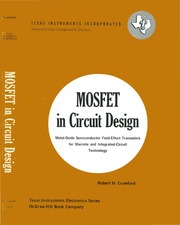ansh11
Member level 4
I am trying to understand how IRF450 MOSFET work. I looked into this datasheet https://datasheetspdf.com/pdf/1322660/STMicroelectronics/IRF450/1 but I don't understand how MOSFET work? When does it turn ON and OFF?
Follow along with the video below to see how to install our site as a web app on your home screen.
Note: This feature may not be available in some browsers.


Absolutely not!The n channel power MOSFET is switched on by applying a positive voltage on its gate terminal. According to its datasheet, the threshold voltage is 2-4V. So, you could put a 3V on gate.
Please be aware the gate rating represent the gate oxide thickness that could withstand the maximum Vgs voltage. It does not correlate to the threshold voltage.Absolutely not!
Some of them conduct only 0.25mA (250uA) when the gate-source voltage is a threshold voltage of only 4V then they will conduct even less at 3V. The datasheet guarantees that all of them conduct well (with a low on-resistance) when the Vgs is 10V.
Hi KlausHi,
I agree with @Audioguru.
The datasheet says: V_GS_TH = 2...4V for a tiny current of 250uA.
This is not considered as ON state for a switch.
@danadakk gives good information about: the behviour between a load and switch.
But - in opposite to a regulator - a "switch" always is overdriven to ensure low ohmic Drain-Source even at worst case condition. (temperature, production tolerance... )
No good designer will drive the IRF450 as a "switch" with only V_GS = 4V... and using 3V makes no sense at all. ... even if the load current is below 0.001A
(it also makes no sense to use a 13A rated MOSFET for only 0.001A load current)
Klaus
Howdo AudioguruKorean, you talk of how Mosfets are made today and you talk about Vgs breakdown.
The IRF540 Mosfet is OLD and has a Vgs breakdown rating of 20V but its datasheet shows that it works well with a Vgs of 10V.
The IRL540 Mosfet is newer but is still so old that it is almost obsolete. It has a Vgs breakdown of 10V and it works well with a Vgs of 4V and 5V.
The curves on a datasheet are for devices that have "typical" specs, not for many devices that have minimum and maximum specs.